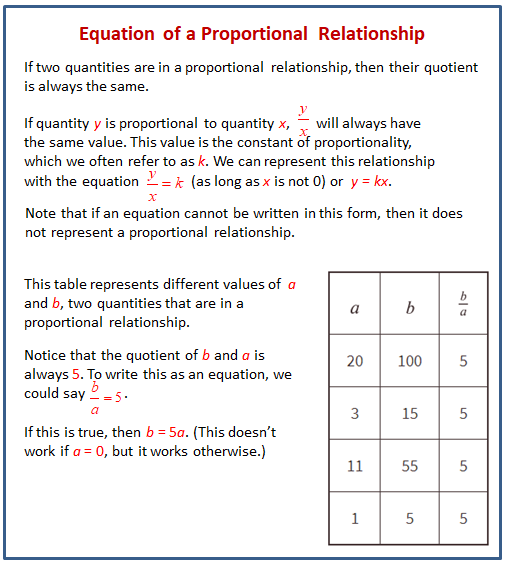Illustrative Mathematics Grade 7, Unit 2, Lesson 8: Comparing Relationships with Equations
Learning Targets:
- I can decide if a relationship represented by an equation is proportional or not.
Related Pages
Illustrative Math
Grade 7
Lesson 8: Comparing Relationships with Equations
Let’s develop methods for deciding if a relationship is proportional.
Illustrative Math Unit 7.2, Lesson 8 (printable worksheets)
Lesson 8 Summary
The following diagram shows how to decide if a relationship represented by an equation is proportional or not.

Lesson 8.1 Notice and Wonder: Patterns with Rectangles
Do you see a pattern? What predictions can you make about future rectangles in the set if your pattern continues?
Lesson 8.2 More Conversions
The other day you worked with converting meters, centimeters, and millimeters. Here are some more unit conversions.
- Use the equation F = 9/5 C + 32, where F represents degrees Fahrenheit and C represents degrees Celsius, to complete the table.
- Use the equation c = 2.54n, where c represents the length in centimeters and n represents the length in inches, to complete the table.
- Are these proportional relationships? Explain why or why not.
Lesson 8.3 Total Edge Length, Surface Area, and Volume
Here are some cubes with different side lengths. Complete each table. Be prepared to explain your reasoning.
- How long is the total edge length of each cube?
- What is the surface area of each cube?
- What is the volume of each cube?
- Which of these relationships is proportional? Explain how you know.
- Write equations for the total edge length E, total surface area A, and volume V of a cube with side length .
Are you ready for more?
- A rectangular solid has a square base with side length l, height 8, and volume V. Is the relationship between l and V a proportional relationship?
-
Show Answer
No
-
Show Answer
- A different rectangular solid has length l, width 10, height 5, and volume V. Is the relationship between l and V a proportional relationship?
-
Show Answer
Yes
-
Show Answer
- Why is the relationship between the side length and the volume proportional in one situation and not the other?
-
Show Answer
The equation for question 1 is V = 8l2. The relationship between l and V is not a proportional relationship.
The equation for question 1 is V = 50l. The relationship between l and V is a proportional relationship.
-
Show Answer
Lesson 8.4 All Kinds of Equations
Here are six different equations.
y = 4 + x
y = 4x
y = 4/x
y = x/4
y = 4x
y = x4
- Predict which of these equations represent a proportional relationship.
- Complete each table using the equation that represents the relationship.
- Do these results change your answer to the first question? Explain your reasoning.
- What do the equations of the proportional relationships have in common?
Lesson 8 Practice Problems
- The relationship between a distance in yards (y) and the same distance in miles (m) is described by the equation y = 1760m.
a. Find measurements in yards and miles for distances by filling in the table.
b. Is there a proportional relationship between a measurement in yards and a measurement in miles for the same distance? Explain why or why not. - Decide whether or not each equation represents a proportional relationship.
a. The remaining length (L) of 120-inch rope after inches have been cut off: 120 = x = L
b. The total cost (t) after 8% sales tax is added to an item’s price (p): 1.08p = t.
c. The number of marbles each sister gets (x) when m marbles are shared equally among four sisters: x = m/4
d. The volume (V) of a rectangular prism whose height is 12 cm and base is a square with side lengths s cm: V = 12s2 - a. Use the equation y = 5/2 x to fill in the table.
Is y proportional to x and y? Explain why or why not.
b. Use the equation y = 3.2x + 5 to fill in the table.
Is y proportional to x and y? Explain why or why not. - To transmit information on the internet, large files are broken into packets of smaller sizes. Each packet has 1,500 bytes of information. An equation relating packets to bytes of information is given by b = 1,500p where p represents the number of packets and b represents the number of bytes of information.
a. How many packets would be needed to transmit 30,000 bytes of information?
b. How much information could be transmitted in 30,000 packets?
c. Each byte contains 8 bits of information. Write an equation to represent the relationship between the number of packets and the number of bits.
The Open Up Resources math curriculum is free to download from the Open Up Resources website and is also available from Illustrative Mathematics.
Try out our new and fun Fraction Concoction Game.
Add and subtract fractions to make exciting fraction concoctions following a recipe. There are four levels of difficulty: Easy, medium, hard and insane. Practice the basics of fraction addition and subtraction or challenge yourself with the insane level.

We welcome your feedback, comments and questions about this site or page. Please submit your feedback or enquiries via our Feedback page.